Torrieri D. Principles of Spread-Spectrum Communication Systems
Подождите немного. Документ загружается.

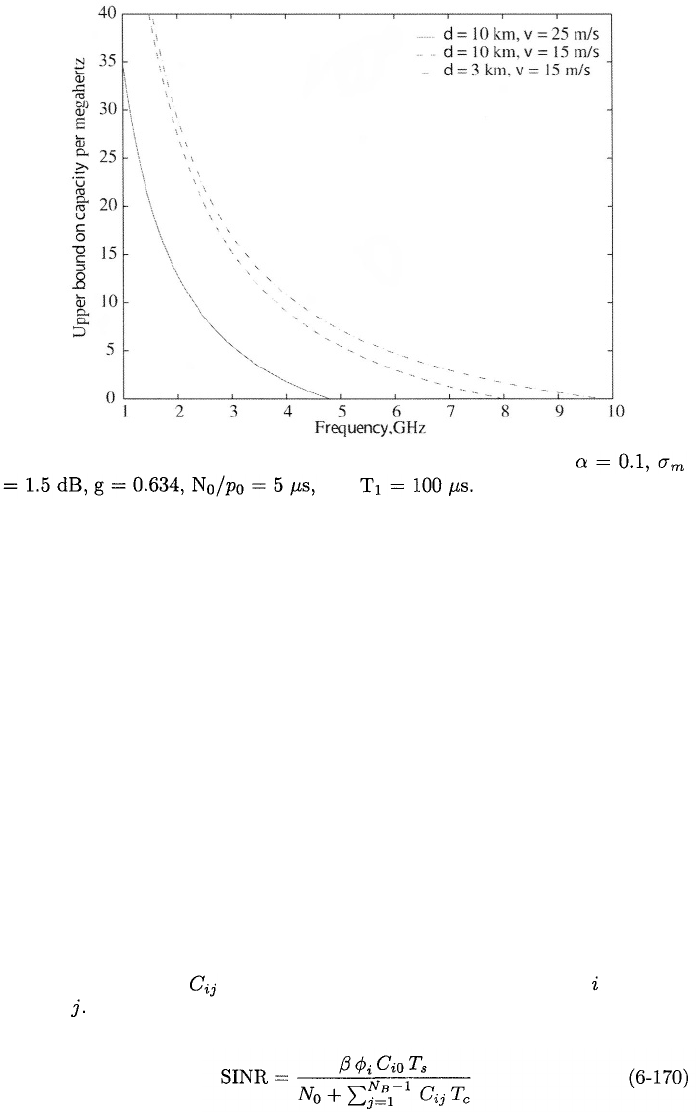
348
CHAPTER 6.
CODE-DIVISION MULTIPLE ACCESS
Figure 6.20: Upper bound on uplink capacity per megahertz for
and
component, and to assess the power-allocation requirement of the mobile.
A base station synchronously combines and transmits the pilot and all the
signals destined for mobiles associated with it. Consequently, all the signals fade
together, and the use of orthogonal spreading sequences will prevent intracell
interference and, hence, a near-far problem on a downlink, although there will
be interference caused by asynchronously arriving multipath components. The
orthogonal sequences can be generated from the rows of a Hadamard matrix.
The orthogonality, the energy-saving sharing of the same pilot at all covered
mobiles, and the coherent demodulation of all transmitted signals are major
advantages of the downlinks. However, interference signals from other base
stations arrive at a mobile asynchronously and fade independently, thereby
significantly degrading performance.
Although there is no near-far problem on the downlinks, power control is
still desirable to enhance the received power during severe fading or when a
mobile is near a cell edge. However, this power enhancement increases inter-
cell interference. Downlink power control entails power allocation by the base
station in a manner that meets the requirements of the individual mobiles as-
sociated with it. Let denote the total power received by mobile from base
station If this mobile is associated with base station 0, then the SINR at the
mobile is
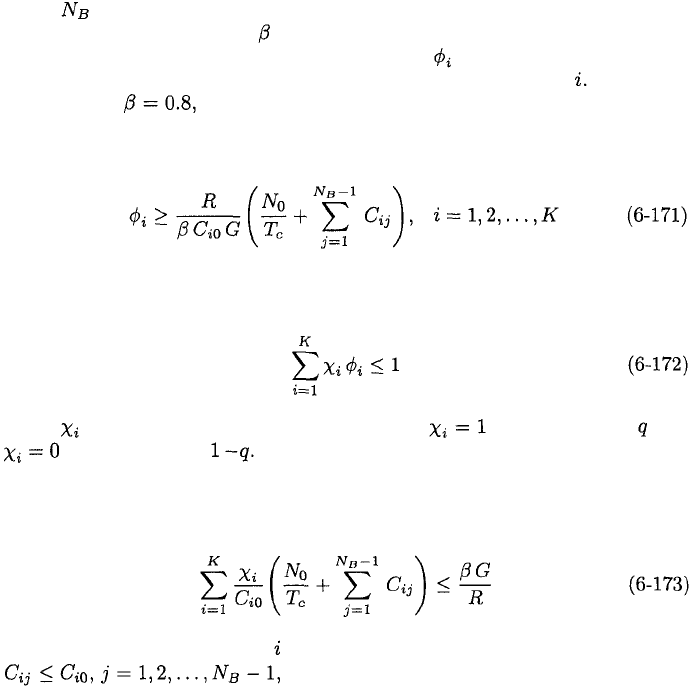
6.5.
MULTIUSER DETECTORS
349
where is the total number of base stations that produce significant power
at mobiles in a cell or sector, is the fraction of the base-station power that is
assigned to mobiles rather than to the pilot, and is the fraction of the total
power for mobiles in a cell or sector that is allocated to mobile Typically,
one might set which entails a 1-dB loss due to the pilot. Let R denote
the SINR required by network mobiles for acceptable performance. Inverting
(6-170), it is found that R is achieved by all mobiles in a cell or sector if
An outage occurs if the demands of all K mobiles in a cell or sector cannot be
met simultaneously. Thus, no outage occurs if (6-171) is satisfied and
where is the voice-activity indicator such that with probability and
with probability If the left-hand side of (6-172) is strictly less than
unity, then the transmitted power produced by base station 0 can be safely
lowered to reduce the interference in other cells or sectors. Combining (6-171)
and (6-172), a necessary condition for no outage is
The assignment of mobile to base station 0 implies the constraint that
except possibly during a soft handoff. A com-
plete performance analysis with this constraint is difficult. Simulation results
[19] indicate that the downlink capacity potentially exceeds the uplink capacity
if the orthogonal signaling is not undermined by excessive multipath.
6.5
Multiuser Detectors
The conventional single-user direct-sequence receiver of Figure 2.14 is optimal
against multiple-access interference only if the spreading sequences of all the
interfering signals and the desired signal are orthogonal. Orthogonality is possi-
ble in a synchronous communication network, but in an asynchronous network,
it is not possible to find sequences that remain orthogonal for all relative delays.
Thus, the conventional single-user receiver, which only requires knowledge of
the spreading sequence of the desired signal, is suboptimal against asynchronous
multiple-access interference. The price of the suboptimality might be minor if
the spreading sequences are carefully chosen and the noise is relatively high,
especially if an error-control code and a sector antenna or adaptive array are
used. If a potential near-far problem exists, power control may be used to limit

350
CHAPTER 6.
CODE-DIVISION MULTIPLE ACCESS
its impact. However, power control is imperfect, entails a substantial overhead
cost, and is not feasible for peer-to-peer communication networks. Even if the
power control is perfect, the remaining interference causes a nonzero error floor,
which is a minimum bit error probability that exists when the thermal noise is
zero. Thus, an alternative to the conventional receiver is desirable.
A multiuser detector is a receiver that exploits the deterministic structure
of multiple-access interference or uses joint processing of a set of multiple-
access signals. An optimum multiuser detector almost completely eliminates
the multiple-access interference and, hence, the near-far problem, thereby ren-
dering power control unnecessary, but such a detector is prohibitively complex
to implement, especially when long spreading sequences are used. A more
practical multiuser detector alleviates but does not eliminate the power-control
requirements of a cellular network on its uplinks. Even if a multiuser detec-
tor rejects intracell interference from mobiles within a cell, it cannot reject
intercell interference, which arrives from mobiles associated with different base
stations than the one receiving a desired signal. Since intercell interference is
typically more than one-third of the total interference on an uplink, even ideal
multiuser detection will increase network capacity by a factor less than three.
Multipath components can be accommodated as separate interference signals
or rake combining may precede the multiuser detection. Though suboptimal
compared with ideal multiuser detection, multiuser interference cancellers bear
a much more moderate implementation burden and still provide considerable
interference suppression. However, it appears that accurate power control is still
needed at least for initial synchronization and to avoid overloading the front
end of the receiver. Third-generation CDMA systems use adaptive interference
cancellation but retain a closed-loop power-control subsystem.
Optimum Detectors
Consider a DS/CDMA network with K users, each of which uses PSK to trans-
mit a block of N binary symbols. A jointly optimum detector makes collective
symbol decisions for K received signals based on the maximum a posteriori
(MAP) criterion. The individually optimum detector selects the most proba-
ble set of symbols of a single desired signal from one user based on the MAP
criterion, thereby providing the minimum symbol error probability. In nearly
all applications, jointly optimum decisions would be preferable because of their
lower complexity and because both types of decisions will agree with very high
probability unless the symbol error probability is very high. Assuming equally
likely symbols are transmitted, the jointly optimum MAP detector is the same
as the jointly optimum maximum-likelihood detector, which is henceforth re-
ferred to as the optimum detector.
For synchronous communications in the presence of white Gaussian noise,
the symbols are aligned in time, and the detection of each symbol of the desired
signal is independent of the other symbols. Thus, the optimum detector can
be determined by considering a single symbol interval Let
denote the symbol transmitted by user The customary (highly idealized)

6.5.
351
assumption is that a perfect carrier synchronization enables the receiver to
remove a common carrier frequency and phase. Thus, the composite baseband
received signal is
where is the received symbol amplitude from user is the unit-energy
spreading waveform of user and is the baseband Gaussian noise.
If it is assumed that each of the K signals has a common carrier frequency but
a distinct phase relative to the phase of the receiver-generated synchronization
signal, then each in (6-174) is replaced by where is the relative
phase of the signal from mobile
Assuming that all possible values of the symbol vector are
equally likely, the optimum detector is the maximum-likelihood detector [22],
[23], which selects the value of d that minimizes the log-likelihood function
subject to the constraint that The vector of the cross correla-
tions between and the spreading sequences is denoted by
where
Let A denote the K × K diagonal matrix with diagonal components
Let R denote the K × K correlation matrix with elements
where and because the spreading waveforms are normalized
to unit energy. Expanding (6-175), dropping an integral that is irrelevant to
the selection of d, and then substituting (6-176) and (6-177), we find that
the maximum-likelihood detector selects the value of d that maximizes the
correlation metric
subject to the constraint that or
This equation implies that the optimum detector uses a filter bank of K
parallel correlators. Correlator computes given by (6-176) and can be
implemented as the single-user detector of Figure 6.15. Equation (6-178) also
indicates that the K spreading sequences must be known so that R can be
calculated, and the K signal amplitudes must be estimated. Short spreading
sequences are necessary or R must change with each symbol. The optimum
detector is capable of making joint symbol decisions for all K signals or merely
the symbol decisions for a single signal.
MULTIUSER DETECTORS
or
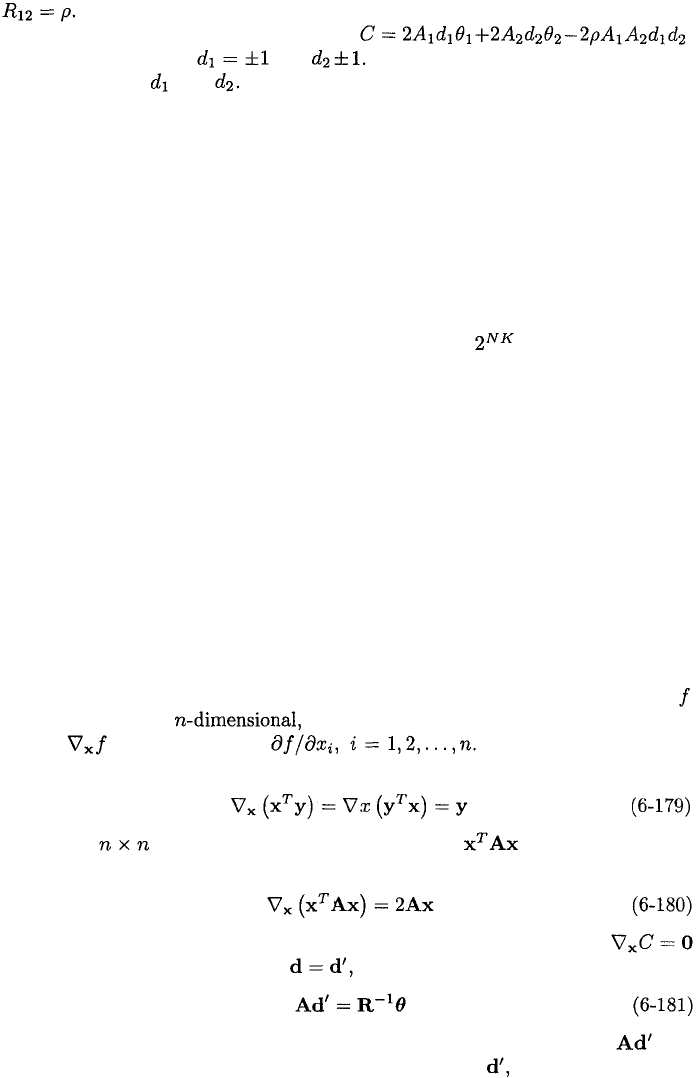
352
CHAPTER 6. CODE-DIVISION MULTIPLE ACCESS
As an example, consider synchronous communications with K = 2 and
After the elimination of terms irrelevant to the selection, (6-178) im-
plies that the optimum detector evaluates
for the four pairs with and The pair that maximizes C provides
the decisions for and
For asynchronous communications over the AWGN channel, the derivation
of the maximum-likelihood detector is analogous but more complicated [22],
[23]. A major difference is that a desired symbol overlaps two consecutive sym-
bols from each interference signal. The optimum detector uses a filter bank of
K parallel correlators, but N symbols from each correlator must be processed
to make decisions about NK binary symbols. The vector d is NK ×
1
with
the first N elements representing the symbols of signal 1, the second N ele-
ments representing the symbols of signal 2, etc. The detector must estimate
the transmission delays of all K multiple-access signals, and the NK × NK
correlation matrix R has components that are partial cross correlations among
the signals. In principle, the detector must compute correlation metrics
and then select K symbol sequences, each of length
N
, corresponding to the
largest correlation metric. The Viterbi algorithm simplifies computations by
exploiting the fact that each received symbol overlaps at most 2(K – 1) other
symbols. Nevertheless, the computational complexity increases exponentially
with K.
In view of both the computational requirements and the parameters that
must be estimated, it is highly unlikely that the optimum multiuser detector
will have practical applications. Subsequently, alternative suboptimal multiuser
detectors are considered. All of them follow carrier removal with a filter bank
of correlators.
Decorrelating detector
The decorrelating detector may be derived by maximizing the correlation metric
of (6-178) without any constraint on d. For this purpose, the gradient of
with respect to the real-valued vector x is defined as the column
vector with components From this definition, it
follows that for column vectors x and
y
If A is an symmetric matrix, then expressing in component form
and using the chain rule yields
Applying (6-179) and (6-180) to the correlation metric, we find that
implies that C is maximized by where
provided that R is invertible. Since each component of the vector is a
positive multiple of the corresponding component of there is no need to
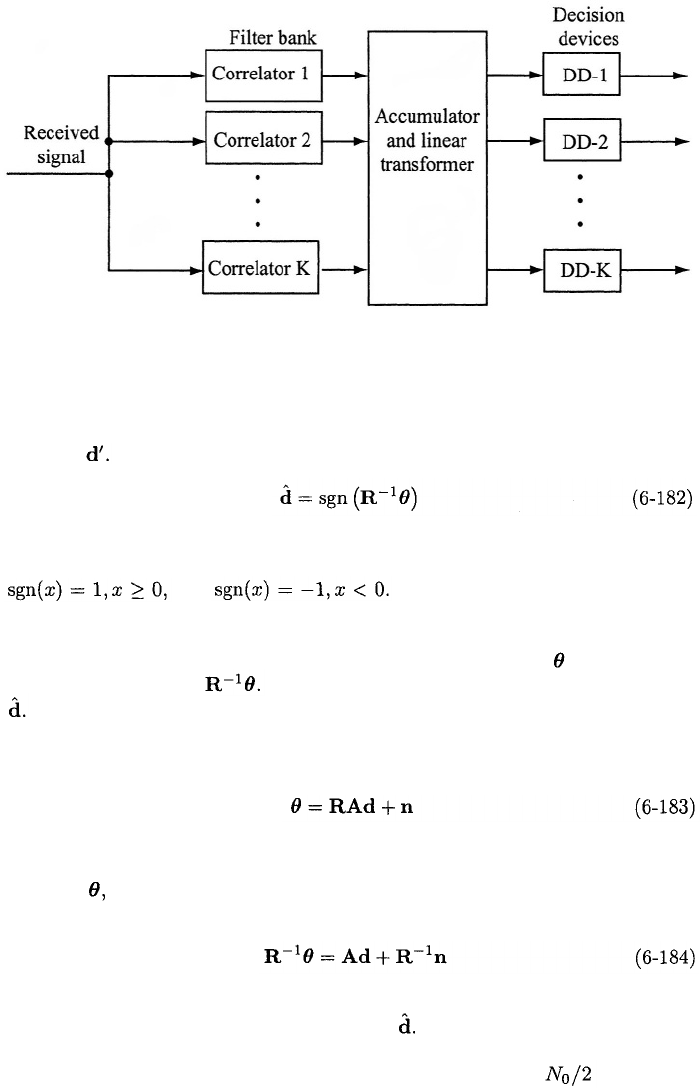
6.5.
353
Figure 6.21: Architecture of decorrelating detector and MMSE detecter. Filter
bank comprises parallel correlators.
solve for A suitable estimate of the transmitted bits is
where each component of the vector sgn(x) is the signum function of the cor-
responding component of the vector x. The signum function is defined as
and The decorrelating detector, which
implements (6-182), has the form diagrammed in Figure 6.21. For asynchro-
nous communications, each of the K correlators in the filter bank produces N
bits. The accumulator constructs the NK-dimensional vector and the linear
transformer computes The decision devices evaluate (6-182) to produce
A second derivation of the decorrelating detector assumes that the detector
has the filter bank as its first stage. If (6-174) gives the input, then the output
of this stage is
where n is the NK-dimensional noise vector. This equation indicates that the
coupling among components of d, which causes the correlation among compo-
nents of is due solely to the presence of the matrix R. The effect of this
matrix is removed by computing
If (6-182) is used to determine the NK transmitted bits, the multiple-access
interference is completely decorrelated from
A third derivation assumes the presence of the filter bank. If zero-mean,
white Gaussian noise with two-sided power spectral density enters each
correlator, then a straightforward calculation indicates that the NK × NK
MULTIUSER DETECTORS
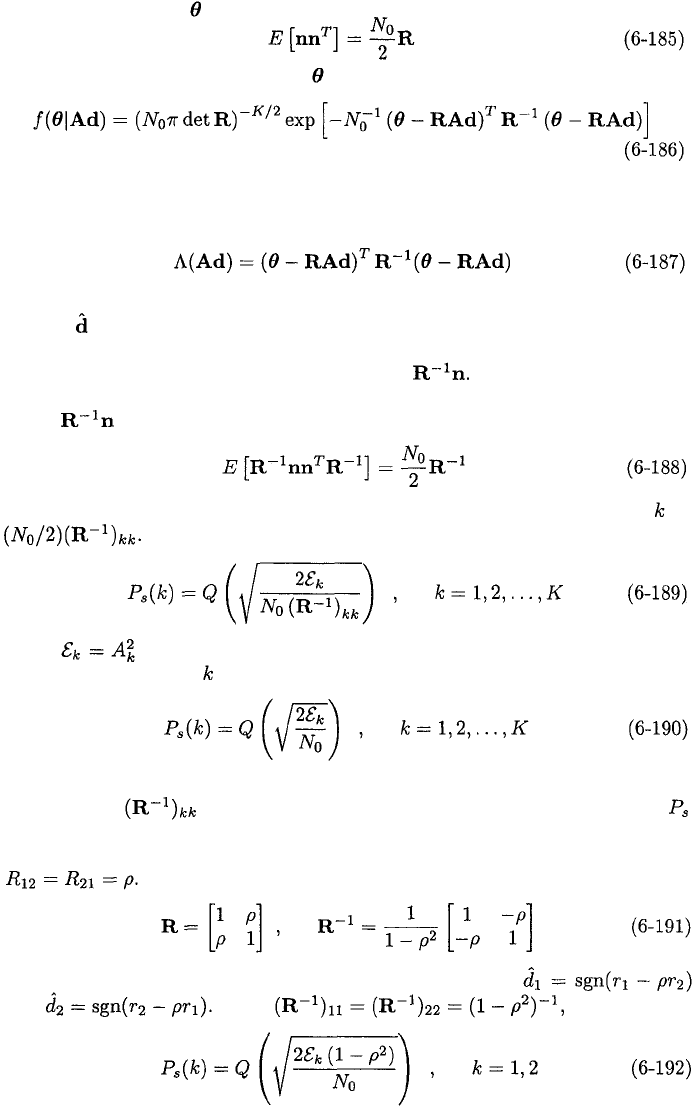
354
CHAPTER 6.
CODE-DIVISION MULTIPLE ACCESS
covariance matrix of is
The probability density function of given Ad is
The maximum-likelihood estimate of Ad is the estimate that maximizes (6-
186) or, equivalently, minimizes the log-likelihood function
Using (6-179) and (6-180), we again obtain the estimate given by (6-181), which
leads to given by (6-182).
Although the decorrelating detector eliminates the multiple-access interfer-
ence, it increases the noise by changing n to From (6-185), and the
symmetric character of R, it follows that the covariance matrix of the noise
vector entering the decision devices is
The variance of the noise that accompanies one of the symbols of user is
Therefore, the symbol error probability is
where is the symbol energy. The symbol error probability for single-
user detection by user in the absence of multiple access interference is
Thus, the presence of multiple-access interference requires an increase of energy
by the factor when the decorrelating detector is used if a specified
is to be maintained.
As an example, consider synchronous communications with K = 2 and
The correlation matrix and its inverse are
Equation (6-182) indicates that the symbol estimates are
and Since
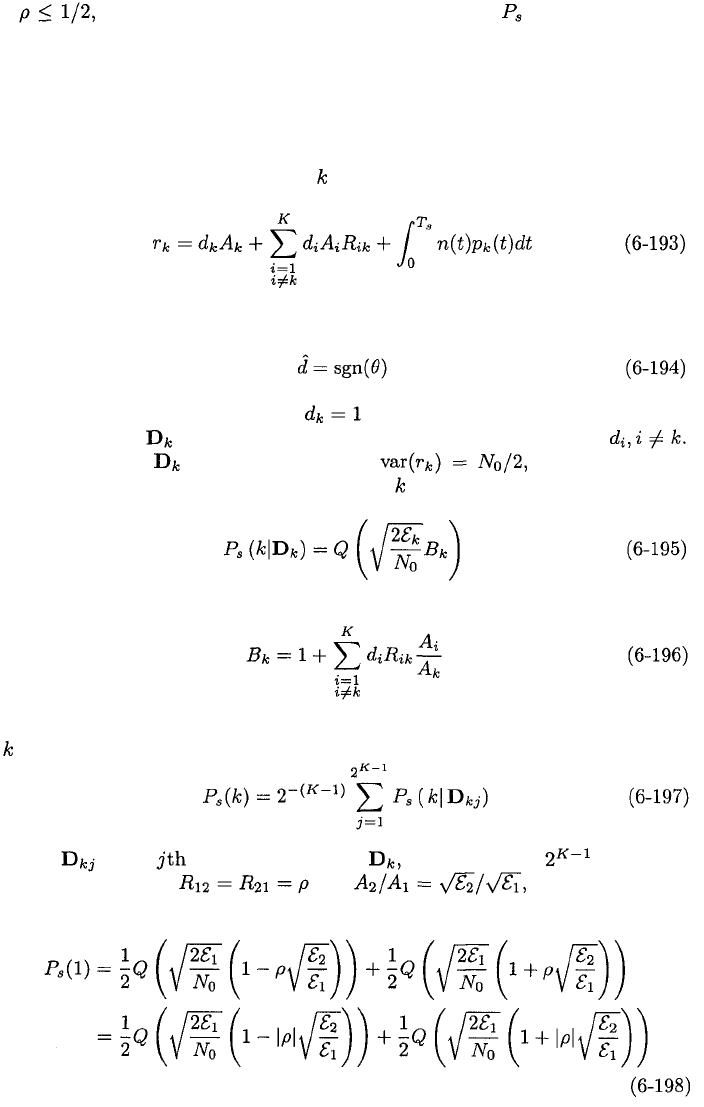
6.5.
MULTIUSER DETECTORS
355
If the required energy increase or shift in each curve is less than
1.25
dB.
To demonstrate analytically the advantage of the decorrelating detector,
consider synchronous communications and a receiver with a filter bank of K
conventional detectors. Each conventional detector is a single-user matched
filter. If perfect carrier synchronization removes a common phase shift of all
the signals and produces the baseband received signal of (6-174), then (6-176)
implies, that the output of detector is
The set of K symbols is estimated by
By symmetry, we can assume that in the evaluation of the symbol error
probability. Let denote the (K – 1)-dimensional
vector of all the
Conditioning on and calculating that we find that the
conditional symbol error probability for user is
where
If all symbol sets are equally likely, then the symbol error probability for user
is
where is the choice of the vector which can take values.
For K= 2 with and (6-195) to (6-197)
yield the symbol error probability for user 1:
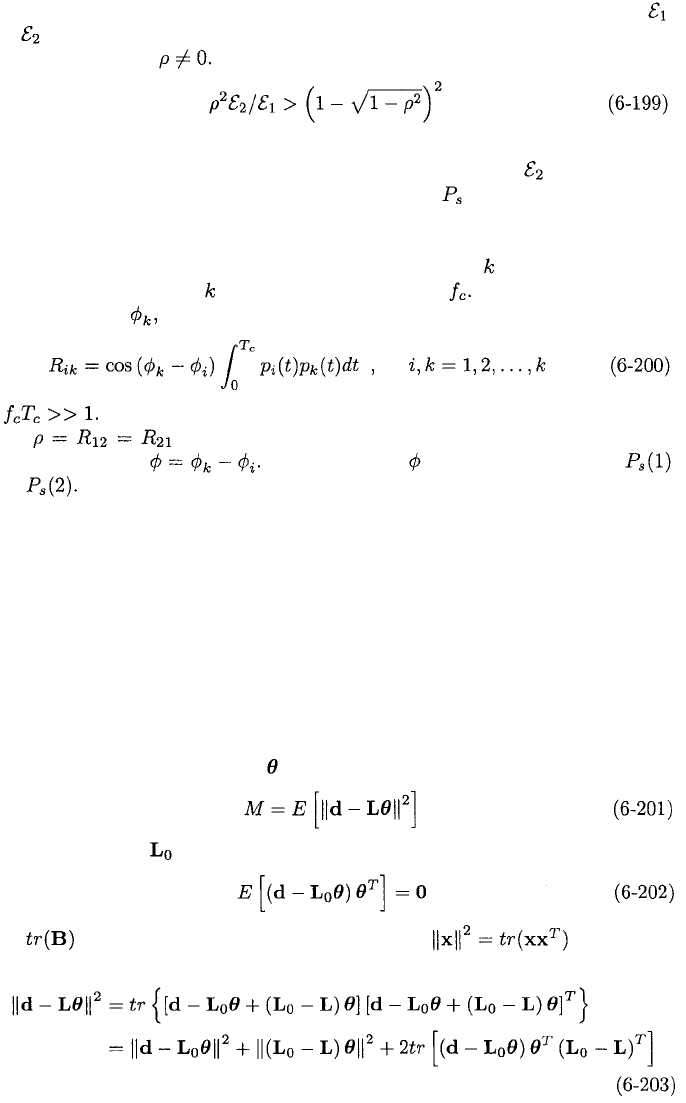
356
CHAPTER 6.
CODE-DIVISION MULTIPLE ACCESS
The symbol error probability for user 2 is given by (6-198) with the roles of
and interchanged. The second term in (6-198) is usually negligible compared
with the first one if Thus, if
then a comparison of (6-198) with (6-192) indicates that decorrelating detector
usually outperforms the conventional detector. However, if is sufficiently
small, then the conventional detector gives a lower than the decorrelating
detector.
In a more realistic model of the decorrelating and conventional detectors,
the received signal in Figure 6.21 is passband. Correlator uses a synchronized
carrier to remove carrier at the common frequency Since each carrier has
a distinct phase
the elements of the correlation matrix are
if For synchronous communications with K = 2, (6-192) and (6-198)
with then represent the conditional symbol error probability
given the value of Averaging over is necessary to obtain
and
Compared with the optimum detector, the decorrelating detector offers
greatly reduced, but still formidable, computational requirements. There is no
need to estimate the signal amplitudes, but the transmission delays of asynchro-
nous signals must still be estimated. The inversion of the correlation matrix
R in real time is not possible for asynchronous signals with practical values
of NK. Suboptimal partitioning and short spreading sequences are generally
necessary and degrade the theoretical performance given by (6-189).
Minimum-Mean-Square-Error Detector
The minimum-mean-square-error (MMSE) detector is the receiver that results
from a linear transformation of by the K × K matrix L such that the metric
is minimized. Let denote the solution of the equation
Let denote the trace of the matrix B. Since
for a vector
x,
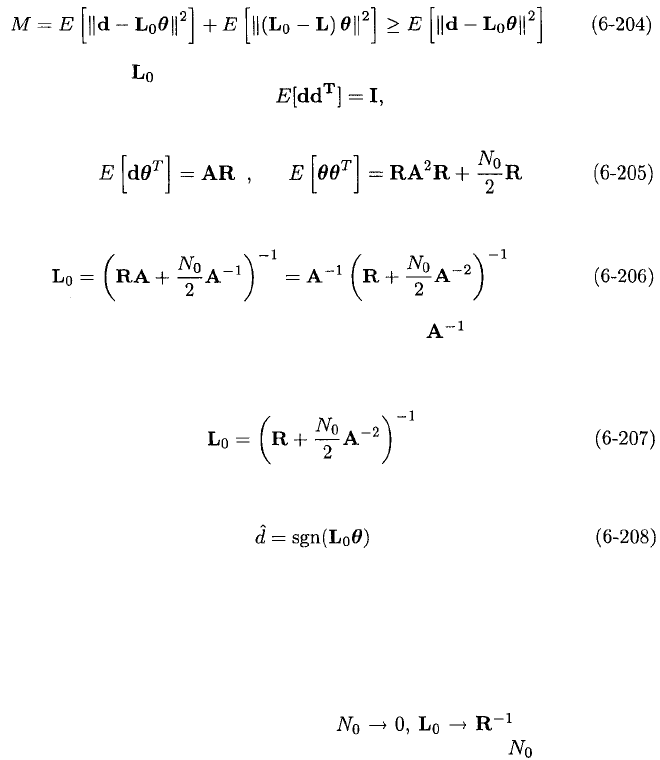
6.5.
MULTIUSER DETECTORS
357
Substitution of this equation into (6-201) and the application of (6-202) yields
which proves that minimizes M. If the data symbols are independent and
equally likely to be +1 or –1, then where I is the identity matrix.
Using this result, (6-183), (6-185), E[n] =
0,
and the independence of d and n,
we obtain
Substitution of these equations into (6-202) yields
provided that the inverses exist. Since A and, hence, are diagonal matrices
with positive diagonal components if all
-
signals are active, (6-206) may be
simplified to the linear transformation matrix
without any change in the MMSE estimate of the transmitted symbols:
The MMSE detector has the structure of Figure 6.21.
The MMSE and decorrelating detectors have almost the same computational
requirements, and they both have equalizer counterparts, but they differ in
several ways. The MMSE detector is near-far resistant, but does not obliterate
the multiple-access interference and, hence, does not completely eliminate the
near-far problem. However, it does not accentuate the noise to the degree
that the decorrelating detector does. As and the MMSE
estimate approaches the decorrelating detector estimate. As increases, the
MMSE estimate approaches that of the conventional detector given by (6-194),
and the symbol error probability generally tends to be lower than that provided
by the decorrelating detector. A disadvantage of the MMSE detector is that
the signal amplitudes must be estimated so that A in (6-207) can be computed.
For either the MMSE or decorrelating linear detectors to be practical, it
is necessary for the spreading sequences to be short. Short sequences ensure
that the correlation matrix R is approximately constant for significant time
durations if the communication channel and the amplitudes of the interference
signals are slowly varying. The price of short sequences is a security loss and the
occasional but sometimes persistent performance loss due to a particular set of
relative signal delays. Even with short spreading sequences, adaptive versions
of the MMSE detector are much more practical than the nonadaptive versions
of either linear detector.
